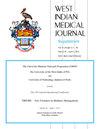口腔黏膜疾病患者唾液中hβD-1和hβD-2水平的评价
IF 0.3
4区 医学
Q4 MEDICINE, GENERAL & INTERNAL
引用次数: 2
摘要
目的本研究旨在确定口腔粘膜疾病与唾液中抗微生物肽人β-防御素-1(hbetaD-1)和人β-抵抗素-2(hbetaD-2)浓度之间的可能相关性。方法建立反相高效液相色谱法(RP-HPLC)测定口腔疾病患者唾液中人β-防御素(hbetaD-1和hbetaD-2)的含量。结果hbetaD-1和hbetaD-2防御素的线性校准范围分别为1.67-2000μg mL-1和3.13-100PG mL-1,R2分别为0.9998和0.996。通过将洗脱的hbetaD-1和hbetaD-2的峰面积与其标准品的峰面积进行比较来测定唾液中β-防御素的浓度。通过比较治疗前后口腔粘膜疾病患者和对照受试者的结果来评估β-防御素含量的变化。hbetaD-1的检测限(LOD)和定量限(LOQ)分别为1.62微克/毫升和5.39微克/毫升-1,hbetaD-2的检测限和定量限分别为0.94毫克/毫升和3.13微克/毫升。结论口腔粘膜疾病患者唾液β-防御素浓度明显高于健康志愿者;此外,在口腔粘膜疾病患者中,治疗前的浓度明显高于治疗后。本文章由计算机程序翻译,如有差异,请以英文原文为准。
Evaluation of hβD-1 and hβD-2 levels in saliva of patients with oral mucosal diseases
OBJECTIVE This study aimed to determine a possible correlation between oral mucosal disease and salivary concentrations of the antimicrobial peptides human beta-defensin-1 (hbetaD-1) and human beta-defensin-2 (hbetaD-2). METHOD The present work focussed on the establishment of a reversed phase-high performance liquid chromatography (RP-HPLC) procedure to quantify human beta-defensins (hbetaD-1 and hbetaD-2) in saliva samples of patients with oral diseases such as lichen planus (n = 10), Behcet (n = 10) and recurrent apthous stomatitis (n = 10). RESULTS Linear calibration range for hbetaD-1 and hbetaD-2 defensins was 1.67-200 microg mL-1 and 3.13 -100 PG mL-1 with R2 values of 0.9998 and 0.996, correspondingly. The concentration of beta-defensins in saliva was determined by comparing the peak areas of eluted hbetaD-1 and hbetaD-2 with that of their standards. The variation of the amount of beta-defensins was evaluated by comparisons of the results obtained from the patients with oral mucosal diseases before and after treatments and the control subjects. The limit of detection (LOD) and limit of quantification (LOQ) were found to be 1.62 microg mL-Sand 5.39 microg mL-1 for hbetaD-1 and 0.94 mig mL-1 and 3.13 microg mL-1 for hbetalD-2, respectively. CONCLUSION The salivary beta-defensin concentration was significantly higher in patients with oral mucosal diseases than in healthy volunteers; furthermore, in patients with oral mucosal diseases, the concentration was significantly higher before treatment than after treatment.
求助全文
通过发布文献求助,成功后即可免费获取论文全文。
去求助
来源期刊

West Indian Medical Journal
医学-医学:内科
CiteScore
0.20
自引率
0.00%
发文量
0
审稿时长
4-8 weeks
期刊介绍:
The Journal is international in scope, with author and editorial contributions from across the globe. The focus is on clinical and epidemiological aspects of tropical and infectious diseases, new and re-emerging infections, chronic non-communicable diseases, and medical conditions prevalent in the Latin America-Caribbean region, and of significance to global health, especially in developing countries. The Journal covers all medical disciplines, as well as basic and translational research elucidating the pathophysiologic basis of diseases or focussing on new therapeutic approaches, and publishes original scientific research, reviews, case reports, brief communications, letters, commentaries and medical images. The Journal publishes four to six issues and four supplements annually. English is the language of publication but Abstracts are also duplicated in Spanish. Most of the articles are submitted at the authors’ initiative, but some are solicited by the Editor-in-Chief. Unless expressly stated, the Editorial Board does not accept responsibility for authors’ opinions.
All papers on submission are reviewed by a subcommittee. Those deemed worthy for review are sent to two or three reviewers (one of the three might be a statistician if necessary). The returned papers with reviewer comments are reviewed by the Editor-in-Chief. Papers may be rejected, accepted or sent back to authors for revision. Resubmitted papers from authors are reviewed by the Editor-in-Chief and may be sent back to reviewers or a final decision made by Editor-in-Chief. The decision of the Editorial Board is final with regards to rejected articles. Rejected articles will not be returned to the authors. The editorial subcommittee has the right to return sub-standard manuscripts to the authors, rather than passing them on to the reviewers. This implies outright rejection of the manuscript.
 求助内容:
求助内容: 应助结果提醒方式:
应助结果提醒方式:


